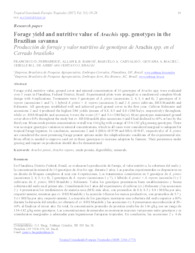Forage yield and nutritive value of Arachis spp. genotypes in the Brazilian savanna.
Forage yield and nutritive value of Arachis spp. genotypes in the Brazilian savanna.
Author(s): FERNANDES, F. D.; CARVALHO, M. A.; MACIEL, G. A.; ASSIS, G. M. L. de; BRAGA, G. J.
Summary: Forage yield, nutritive value, ground cover and mineral concentration of 10 genotypes of Arachis spp. were evaluated over 3 years in Planaltina, Federal District, Brazil. Experimental plots were arranged in a randomized complete block design with 4 replications. Treatments were 5 genotypes of A. pintoi (accessions 2, 4, 5, 6 and 8), 2 genotypes of A. repens (accessions 1 and 7), 1 hybrid A. pintoi × A. repens (accession 3) and 2 A. pintoi cultivars, BRS Mandobi and Belmonte. All genotypes established well and achieved good ground cover in the first year. Cultivar Belmonte and accessions 2 and 4 produced the highest DM yields (means of 8.8, 8.5 and 8.8 t DM/ha/yr, respectively) throughout, while cv. BRS Mandobi and accession 6 were the worst (5.7 and 5.6 t DM/ha/yr). Most genotypes maintained ground cover above 80% throughout the study but cv. BRS Mandobi plus accessions 6 and 8 had declined to 60% or less by the third year. Mean crude protein concentration overall was 166 g/kg with a range of 154‒182 g/kg among genotypes. There was no major genotypic variation in mineral concentrations, which in all cases were considered marginal to adequate for tropical forage legumes. In conclusion, genotypes 2 and 4 (accessions BRA-039799 and BRA-039187, respectively) of A. pintoi are considered the most promising forage peanut options under the edaphoclimatic conditions of the experimental site. More effort is needed to improve seed set in these accessions to increase adoption by farmers. Their persistence under grazing and impact on production should also be demonstrated.
Publication year: 2017
Types of publication: Journal article
Unit: Embrapa Acre
Keywords: Acclimation, Aclimatación, Aclimatação, Amendoim forrageiro, Animal nutrition, Arachis pintoi, Arachis pintoi cv Belmonte, Arachis pintoi cv Mandobi, Cacahuetes forrajeros, Cerrado, Condição ambiental, Digestibilidad, Digestibilidade, Digestibility, Environmental factors, Factores ambientales, Forage legumes, Forage peanuts, Forrageira tropical, Leguminosa forrageira, Leguminosas forrajeras, Nutrición animal, Nutrição animal, Planaltina (DF), Planta forrageira, Proteína vegetal, Variedade resistente, Vegetable protein
Observation
Some of Embrapa's publications are published as ePub files. To read them, use or download one of the following free software options to your computer or mobile device. Android: Google Play Books; IOS: iBooks; Windows and Linux: Calibre.
Access other publications
Access the Agricultural Research Database (BDPA) to consult Embrapa's full library collection and records.
Visit Embrapa Bookstore to purchase books and other publications sold by Embrapa.

